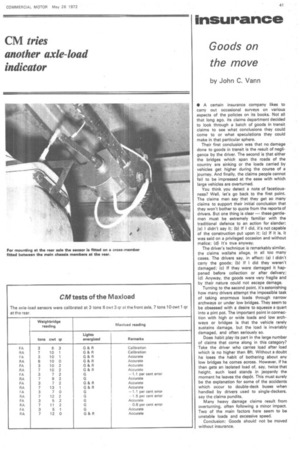Goods on the move
Page 43

If you've noticed an error in this article please click here to report it so we can fix it.
by John C. Vann
• A certain insurance company likes to carry out occasional surveys on various aspects of the policies on its books. Not all that long ago, its claims department decided to look through a batch of goods in transit claims to see what conclusions they could come to or what speculations they could make in that particular sphere.
Their first conclusion was that no damage done to goods in transit is the result of negli gence by the driver. The second is that either the bridges which span the roads of the country are sinking or the loads carried by vehicles get higher during the course of a journey. And finally, the claims people cannot fail to be impressed at the ease with which large vehicles are overturned.
You think you detect a note of facetiousness? Well, let's go back to the first point.
The claims men say that they get so many claims to support their initial conclusion that they won't bother to quote from the reports of drivers. But one thing is clear — these gentle men must be extremely familiar with the traditional defence to an action for slander: (a) I didn't say it; (b) If I did, it's not capable of the construction put upon it; (c) If it is, it was said on a privileged occasion and without malice; (d) Its true anyway.
The driver's technique is remarkably similar, the claims wallahs allege, in all too many cases. The drivers say, in effect: (a) I didn't carry the goods; (la) If I did they weren't damaged; (c) If they were damaged it hap pened before collection or after delivery: (d) Anyway, the goods were very fragile and by their nature could not escape damage.
Turning to the second point, its astonishing how many drivers attempt the impossible task of taking enormous loads through narrow archways or under low bridges. They seem to be obsessed with a desire to squeeze a quart into a pint pot. The important point in connection with high or wide loads and low archways or bridges is that the vehicle rarely sustains damage, but the load is invariably damaged, and often seriously so.
Does habit play its part in the large number of claims that come along in this category?
Take the driver who carries load after load which is no higher than 8ft. Without a doubt he loses the habit of bothering about any low bridges he comes across. However, if he then gets an isolated load of, say, twice that height, such load stands in jeopardy the moment he leaves the depot. This must surely be the explanation for some of the accidents which occur to double-deck buses when handled by drivers used to single-deckers, say the claims pundits.
Many heavy damage claims result from overturning, often following a minor impact. Two of the main factors here seem to be unstable loads and excessive speed.
Conclusion: Goods should not be moved without insurance.




































































































